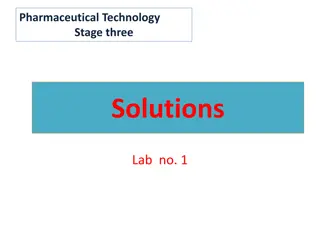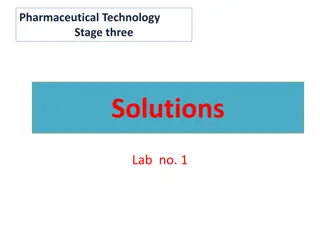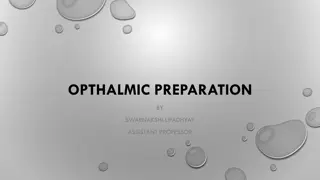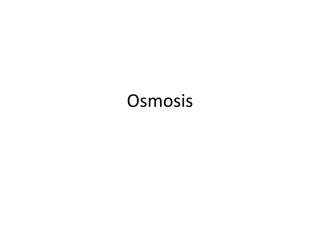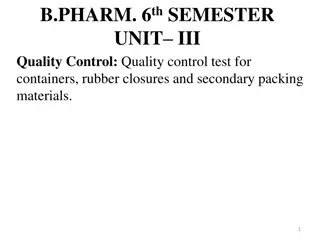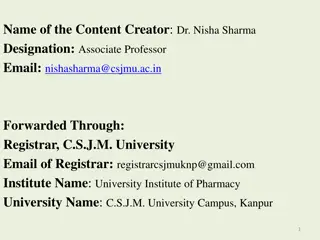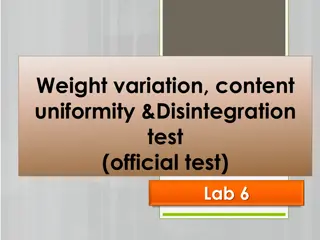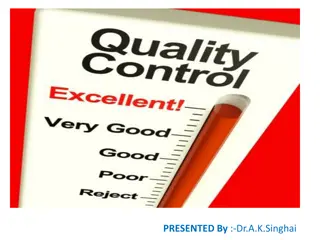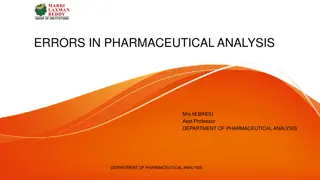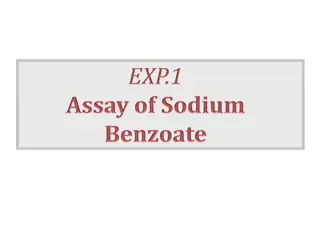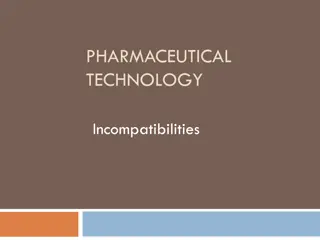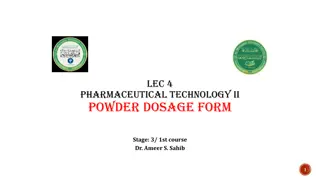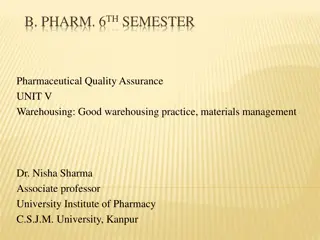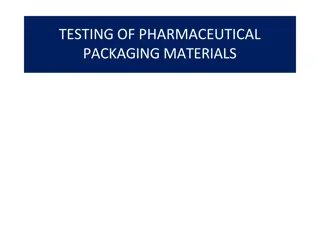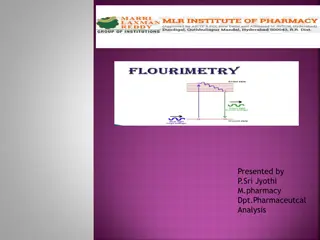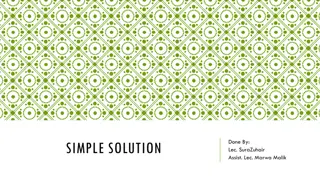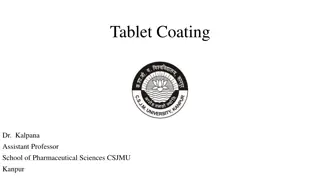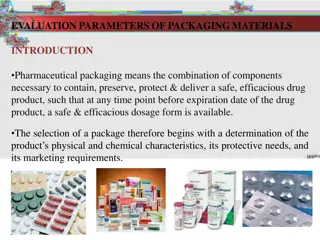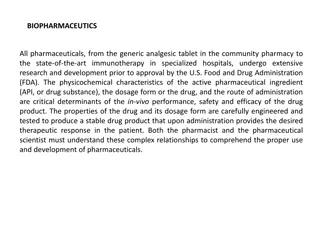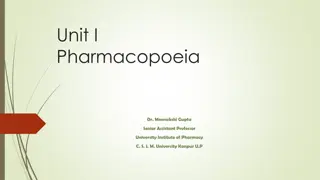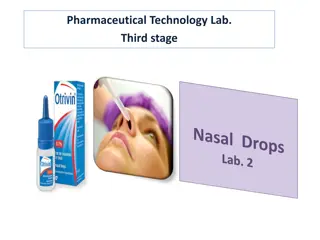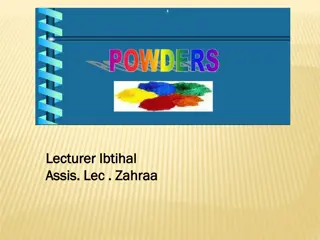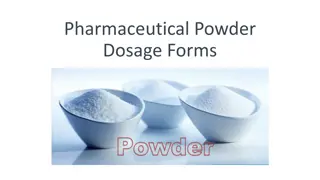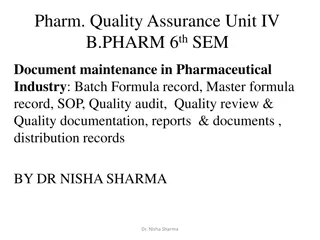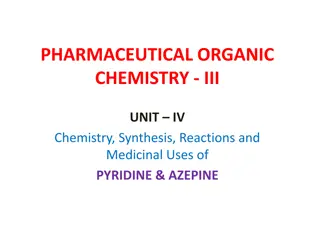Adjusting Tonicity and pH in Pharmaceutical Solutions
Methods to adjust the isotonicity of pharmaceutical solutions involve calculations based on colligative properties. This ensures solutions are isotonic to avoid side effects like RBC haemolysis. Class-1 methods include adding NaCl to lower freezing point, while Class-2 methods involve adjusting with water and isotonic solutions. Calculating isotonicity relies on factors like freezing point depression and the sodium chloride equivalent method. White Vincent method simplifies preparation of isotonic solutions.
- Pharmaceutical Solutions
- Isotonicity Adjustment
- Colligative Properties
- Tonicity Calculation
- White Vincent
Download Presentation

Please find below an Image/Link to download the presentation.
The content on the website is provided AS IS for your information and personal use only. It may not be sold, licensed, or shared on other websites without obtaining consent from the author. Download presentation by click this link. If you encounter any issues during the download, it is possible that the publisher has removed the file from their server.
E N D
Presentation Transcript
LESSON 10 Methods of adjusting Tonicity and pH Several methods are used to adjust the isotonicity of pharmaceutical solutions. Isotonicity can be calculatedfrom the colligative properties of drug solutions. If solutions are injected or introduced in to eyes andnose, these are to be made isotonic in order to avoid haemolysis of RBC s and to avoid pain and discomfort. This is possible for either manufactured orextemporaneous prepared solutions. By using the appropriate calculations based on colligativeproperties of solutions, it is easy to determine the amount of adjusting agents to be added. It helps to overcome the side effects caused from administering solutions which contain adjusting agents less or more than isotonic solutions. The three frequently used methods to calculate isotonicity of the solutions are described below.
Class-1 Methods: Nacl or some other substances is added to the solution of the drug to lower the freezing point of the solution to -0.52 C and thus make the solution isotonic. Examples of this class- Cryoscopic method Sodium chloride equivalent method. 1) 2) Class-2 Methods: Water is added to the drug in a sufficient amount to make it isotonic. Then the preparation is brought to its final volume with an isotonic or buffered isotonic solution.
Class I Methods: Cryoscopic method- Isotonic solutions may be made in terms of data relating to colligative properties of solutions. Colligative properties include osmotic pressure, elevation in boiling point, depression in freezing point, and lowering of vapour pressure. Depression in freezing point is a colligative property which is practical and most convenient for adjusting tonicity. The freezing point of human blood and lacrimal fluids is 0.52 C. This temperature corresponds to freezing point of 0.90% (w/v) sodium chloride solution. This is considered to be isotonic to blood and lacrimal fluids. The freezing point depression of 1% (w/v) sodium chloride ( Tf1%) is 0.58 C. In this method, an amount of tonicity adjuster (e.g. sodium chloride) is added to drug solution such that the final freezing point lowering is that of blood or serum (0.52 C).
Sodium chloride equivalent method- This method is based on calculating the E-value, i.e. the sodium chloride equivalent or tonicity equivalent of a drug. It is the amount of sodium chloride that has the same osmotic effect (i.e. is equivalent to) as 1 g of the drug. Derivation of E-value: Since freezing point depression is a colligative property, it depends on the number of particles, dissociation and association of particles. Therefore, the equation Tf= KfC can be replaced with Tf= LisoC where, T is the depression in freezing point, Kf is the freezing point depression constant, c is the concentration. Liso is a factor that is equal to iKf, where i is the vant Hoff factor. Liso= Tf/ C
Class II Methods: White Vincent method- The Class II methods of computing tonicity involve the addition of water to the drugs to prepare an isotonic solution, followed by the addition of an isotonic or isotonic-buffered diluting vehicle to make up the solution up to the final volume. White and Vincent developed a simplified method for performing such calculations. The equation is derived as shown below: To prepare 30 mL of a 1% (w/v) solution of procaine hydrochloride isotonic with body fluid (=0.3 g), weight of the drug w is multiplied by the sodium chloride equivalent E.
This is the quantity of sodium chloride osmotically equivalent to 0.3 g of procaine hydrochloride = weight of drug (g) E of drug (1) = 0.3 0.21 = 0.063 g It is known that 0.9 g of sodium chloride when dissolved in sufficient water sufficient to make a final volume of 100 mL yields an isotonic solution. The volume V of isotonic solution that can be prepared from 0.063 g of sodium chloride (equivalent to 0.3 g of procaine hydrochloride) is obtained by solving the following proportion: 0.9g / 100ml = 0.063g / V
V = 0.063 X 100 / 0.9 = 7.0ml (2) Accordingly, Eq. (2) can be written as V = w E 111.1 (3) where V is the volume of isotonic solution (in mL) that may be prepared by mixing the drug with water, w the weight of the drug (in grams) and E the sodium chloride equivalent of the drug. The constant, 111.1, represents the volume of isotonic solution in millilitres obtained by dissolving 1 g of sodium chloride in water. The isotonic and isotonic-buffered diluting solutions all have isotonicity values of 0.9% NaCl.
Sprowls method- A further simplification of the method of White and Vincent was prepared by Sprowls. He recognized that the Eq. (3) given by White and Vincent could be utilized to make a table of values of V when the weight of the drug w was arbitrarily fixed. Sprowls chose 0.3 g as the weight of drug, the quantity for one fluid ounce of a 1% solution. The volume V of isotonic solution that can be prepared by mixing 0.3 g of a drug with sufficient water may be computed for drugs commonly formulate as ophthalmic and parenteral solutions. The quantity of isotonic solution is finally brought to the specific volume with the desired isotonic or isotonic-buffered diluting solutions.









